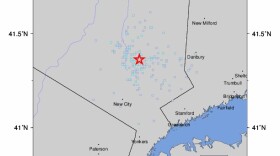Many people in northern Saratoga County had an unusual wake-up alarm today. WAMC’s Southern Adirondack Bureau Chief Lucas Willard reports on this morning’s magnitude 3.1 earthquake.
South Glens Falls and surrounding communities were shaken bright and early Wednesday morning.
Janet Kramer felt and heard the quake in her Greenfield home.
“I thought something exploded in my basement. I thought the furnace blew up because it was like a ‘boom’ and then the house shook. So I thought something exploded.”
Kramer was visiting the New York State Museum on Wednesday, where an instrument called a seismometer measured the quake. Dr. Chuck Ver Straeten, state museum curator of sedimentary rocks, pointed out a blip along what looks like a fuzzy black line on a monitor.
“So that little spike right there that lasted for a few seconds anyway, that was this morning’s earthquake at 6:43.”
The earthquake only lasted between three and six seconds.
Earthquakes are not that uncommon in New York, although most are small and you might not even feel them.
The quake in South Glens Falls happened along the Saratoga fault. Van Straeten showed me that fault on a map.
“So it’s along a fault that cuts close to South Glens Falls, beneath the surface, and then comes down through Saratoga and then comes down toward the Helderbergs in western Albany County, but we’ve never found the fault at the surface in the Helderbergs, like at Thacher Park or something like that,” said Ver Straeten.
Earthquakes can happen when pressure underground builds up and rock breaks, sliding along a fault. While there are many faults in New York, the state is not near a tectonic plate boundary, such as along the Pacific coast. Plate boundaries are massive faults where slabs of rock that can carry entire continents come together.
But the Helderbergs have been active. Ver Straeten says between 2009 and 2011, 60 quakes were recorded in Albany County. Quakes with magnitudes between 3.0 and 4.0 on the Richter scale can be felt, but usually there is little to no damage. He remembers one quake in 2009.
“My wife and I were sitting there, it was like 3 minutes of 9 or something, and we heard this ‘booom.’ Not fireworks boom, ‘Boom! Boom!’ It was ‘Booom.’ And then the windows shook and stuff, you could hear that. Yeah. But not really any damage. Even for an old chimney or something there probably wouldn’t be any damage. Things coming off shelves? Not likely.”
Earthquakes also occur in the New York City area and near the northern border with Canada. The largest quake ever measured in New York state was a magnitude 5.9 in 1944. That earthquake damaged homes in Massena, and across the border in Cornwall, Ontario.






